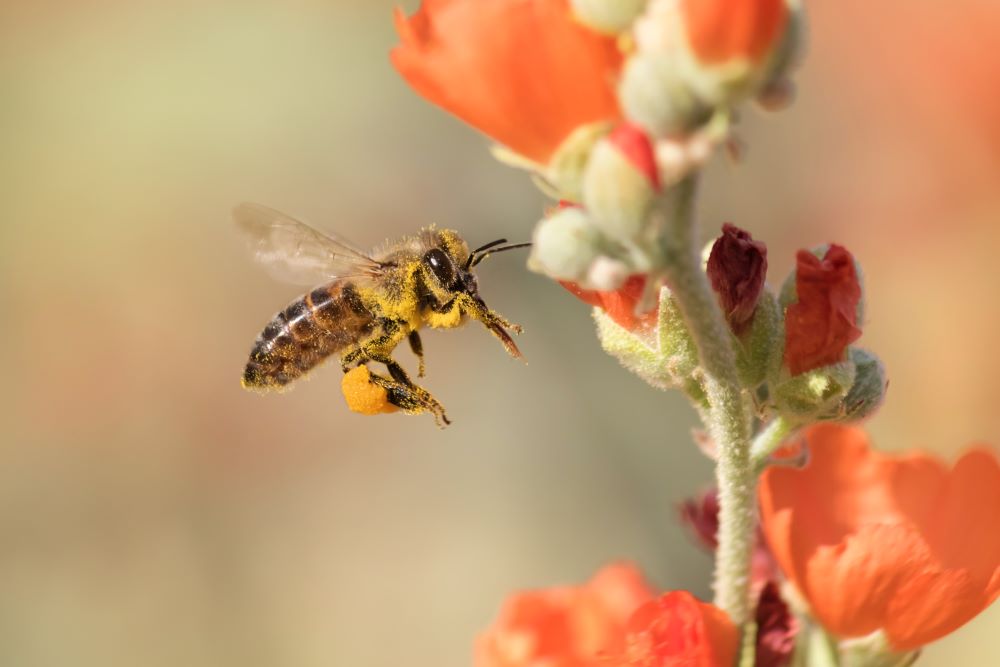
The Most Common Types of Bees in Arizona
Arizona is a hub, for a range of bee varieties each boasting its set of characteristics. Among the spotted bee types in Arizona are honey bees, bumblebees, carpenter bees and Africanized honeybees. Honeybees stand out for their honey making abilities. Are typically found in hives. On the side bumblebees sport a fuzzier body and excel at pollination. Carpenter bees, true to their name, are known for tunneling into wood to establish their homes. Meanwhile Africanized honeybees, nicknamed “killer bees’ ‘ represent a breed that can display aggressive behavior compared to other bee species. It’s essential to grasp the distinctions, among these bee variants when addressing infestations.
In order to tell the difference between these types of bees in Arizona, take a look at their size, color, and how aggressive their behavior is.
Honeybees are usually smaller than other bees you’ll find, measuring around 0.4 inches in length, and are usually golden-brown with black stripes. Bumblebees are larger, with a length of about 0.8 inches, and have a black and yellow fuzzy appearance. Carpenter bees resemble bumble bees but have a shiny black abdomen. Africanized honeybees are similar in appearance to honeybees but are slightly smaller and more aggressive in nature (you’re more likely to get attacked by them more readily).
Understanding the Bee-haviors of Bees
Bees typically build their nests in protected areas, such as tree cavities, wall voids, or underground. Honeybees construct their hives using beeswax, while bumblebees create their nests in abandoned rodent burrows or other hidden spaces. Carpenter bees, as their name suggests, burrow into wood to create their nests. Africanized honey bees are known to be more opportunistic and can build their nests in a variety of locations.
When dealing with a potential bee infestation, it’s important to locate the nest. Look for signs of bee activity, such as a high number of bees flying around a certain area or bees entering and exiting a particular space. Once you have identified the nest, it’s crucial to proceed with caution and take appropriate pest control measures.
What’s the Difference Between Wasps and Bees?
Bees and wasps are often mistaken for one another due to their similar appearance. However, there are distinct differences between these two insects. Bees are generally plump and hairy, while wasps are sleeker and have a smoother body. Bees are also known for their role in pollination, while wasps are more predatory in nature.
Another key difference is their behavior. Bees are typically non-aggressive and will only sting if they feel threatened or their hive is disturbed. Wasps, on the other hand, can be more aggressive and are known to sting repeatedly. It’s important to exercise caution when dealing with wasps, as their stings can be painful and potentially dangerous, especially if you have an allergic reaction.
Pest Control Tips for Dealing with Bee Infestations
Need to remove a serious bee infestation. We have you covered. Here are some tips that can help you in your journey to a sting-free home:
- Figure out what type of bee it is: Look carefully at the bee’s color, size, and behavior to uncover what kind of bee it is. This will help you figure out how dangerous removing them will be.
- Locate the nest: Carefully observe bee activity to identify the location of the nest. This will help you plan the best course of action.
- Avoid DIY removal: Attempting to remove a bee nest on your own can be pretty dangerous, especially if those with allergies live nearby. Contact professional bee removal services that have the experience and tools to safely relocate the bees.
- Protective clothing: If you need to be in close proximity to bees, wear protective clothing, such as a bee suit and veil, to minimize the risk of stings.
Conclusion: Living with Bees in Arizona
Understanding the different types of bees in Arizona and how to handle potential infestations is crucial for coexistence with these important (and sometimes painful) pollinators.
If you encounter a bee infestation, it’s recommended to contact professional bee removal services that can safely remove the bees.
Green Magic Pest Control is here to help Chandler homeowners keep their homes free from bees and wasps year round. Contact us today to set up your free consultation!

